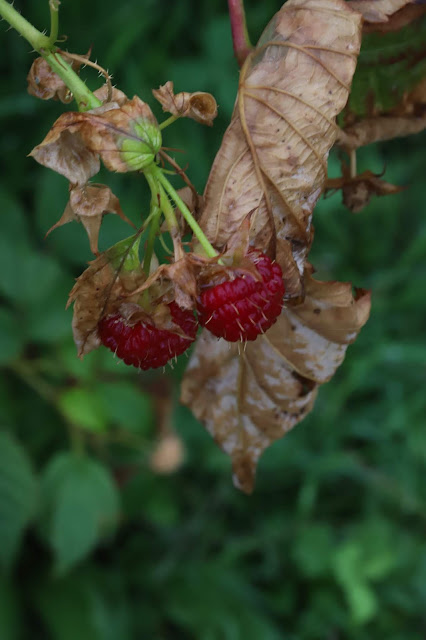Following this past Monday officially ushering in autumn, the rains came and will keep coming all week. After a month of no precipitation, there's the satisfying fragrance of petrichor in the air, the amusing sound of my sabots squelching as I traipse through the garden, and the intriguing sight of soft tonal values switching to intense chiaroscuro with colour accents of deep pink, golden yellow, and mellow claret; at least that is under the ivy-covered pergola where rose of sharon, black eyed susan vine, and bougainvillea are all thriving.
The bougainvillea was gifted to me by the high school student who I tutored for her English exam which she then passed. That summer nearly ten years ago it bloomed well. I dutifully brought it in as the days got shorter as it is not winter hardy in our climate. Since then, the blooming varied from none to sparse. After being placed under the pergola last season for decorative purposes where it still got sun but no rain, it BLOOMED. Research revealed it needed drought stress for those gorgeous sepals to appear. That's right, they are sepals, not blooms. The actual flower is tiny, white, and mostly hidden. Additionally they grow on new wood, so late winter pruning is in order as is light trimming after each bloom cycle. As this variety is a late-bloomer, the show has just begun as it is studded all over with tiny, red sepals. Yes!
These two remaining and totally sodden raspberries are saying no more harvest this season.
Carrots are best planted at the end of May, June, and July when the carrot fly is not so hell bent on laying its eggs at the base of the ferny foliage. These were planted end of July and should be able to be harvested mid November.
As we both don't care for grapes with seeds, the twenty or so vines which were here when we arrived were gradually cut to the ground and allowed to be covered with ivy, but this one managed to fruit!
Turnips which were planted in early September may not have the time to develop roots, but for sure their mild greens will be harvested regardless.
This was the season that the cherry plum tree out front was felled. Now the Box Elder stands alone clearing that area a bit to allow both us and the sun access.
Those plants sidling up the side of the house in the above photo are perennial herbs, specifically sage, fennel, and rosemary. Rosemary had already flowered in the spring and is doing a repeat one now.
The hollow stump of the cherry plum shows clearly it was long past its due date.
The potted crew of shade-loving plants will miss the shadow that the plum tree once cast. They will be re-located under the front balcony entrance and sun-lovers will be put in their place.
À la prochaine!
The bougainvillea was gifted to me by the high school student who I tutored for her English exam which she then passed. That summer nearly ten years ago it bloomed well. I dutifully brought it in as the days got shorter as it is not winter hardy in our climate. Since then, the blooming varied from none to sparse. After being placed under the pergola last season for decorative purposes where it still got sun but no rain, it BLOOMED. Research revealed it needed drought stress for those gorgeous sepals to appear. That's right, they are sepals, not blooms. The actual flower is tiny, white, and mostly hidden. Additionally they grow on new wood, so late winter pruning is in order as is light trimming after each bloom cycle. As this variety is a late-bloomer, the show has just begun as it is studded all over with tiny, red sepals. Yes!
These two remaining and totally sodden raspberries are saying no more harvest this season.
Carrots are best planted at the end of May, June, and July when the carrot fly is not so hell bent on laying its eggs at the base of the ferny foliage. These were planted end of July and should be able to be harvested mid November.
As we both don't care for grapes with seeds, the twenty or so vines which were here when we arrived were gradually cut to the ground and allowed to be covered with ivy, but this one managed to fruit!
Turnips which were planted in early September may not have the time to develop roots, but for sure their mild greens will be harvested regardless.
This was the season that the cherry plum tree out front was felled. Now the Box Elder stands alone clearing that area a bit to allow both us and the sun access.
Those plants sidling up the side of the house in the above photo are perennial herbs, specifically sage, fennel, and rosemary. Rosemary had already flowered in the spring and is doing a repeat one now.
The hollow stump of the cherry plum shows clearly it was long past its due date.
The potted crew of shade-loving plants will miss the shadow that the plum tree once cast. They will be re-located under the front balcony entrance and sun-lovers will be put in their place.
À la prochaine!










No comments:
Post a Comment
Note: only a member of this blog may post a comment.